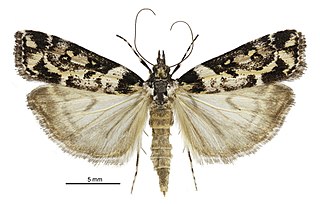Lachnostola is a monotypic moth genus in the family Gelechiidae. Its only species, Lachnostola amphizeucta, is found in South Africa. Both the genus and species were first described by Edward Meyrick in 1918.
Acrocercops lophonota is a moth of the family Gracillariidae. It is known from Java, Indonesia.

Zealandopterix zonodoxa is a moth of the family Micropterigidae. It endemic to New Zealand and is found from the Hawkes Bay north as well as on Poor Knights, Little Barrier and Great Barrier Islands. It is the smallest micropterigid in New Zealand and the shiny white markings on the forewing of this species are variable. It is a day flying moth, but has been collected using UV light. Adults are on the wing from September to March and the species has been witnessed visiting the flowers of Nikau and Cordyline pumilio in large numbers. It inhabits a wide variety of moist indigenous forest but is associated with forests in which podocarps are common. Larvae have been sieved from rotten wood on the floor of a mixed podocarp/broadleaf forest or extracted from moss or from bryophytes.

Eudonia diphtheralis is a species of moth in the family Crambidae. It is endemic to New Zealand.
Epimimastis emblematica is a moth in the family Gelechiidae. It was described by Edward Meyrick in 1916. It is found in Assam, India.
Photodotis prochalina is a moth of the family Gelechiidae. It was described by Edward Meyrick in 1911. It is found in South Africa.
Autosticha xanthographa is a moth in the family Autostichidae. It was described by Edward Meyrick in 1916. It is found in Sri Lanka.
Kertomesis palacta is a moth in the family Autostichidae. It was described by Edward Meyrick in 1911. It is found in India.
Kertomesis rhodota is a moth in the family Autostichidae. It was described by Edward Meyrick in 1911. It is found in India.
Kertomesis stesichora is a moth in the family Autostichidae. It was described by Edward Meyrick in 1911. It is found in India.
Kertomesis anaphracta is a moth in the family Autostichidae. It was described by Edward Meyrick in 1907. It is found in Bhutan and India.
Kertomesis corymbitis is a moth in the family Autostichidae. It was described by Edward Meyrick in 1926. It is found in India.
Antaeotricha corvigera is a moth of the family Depressariidae first described by Edward Meyrick in 1915. It is found in Guyana and Peru.
Heteralcis palathodes is a moth in the family Lecithoceridae. It was described by Edward Meyrick in 1906. It is found in Sri Lanka.
Lecithocera excaecata is a moth in the family Lecithoceridae. It was described by Edward Meyrick in 1922. It is found on Java in Indonesia.
Deltoplastis byssina is a moth in the family Lecithoceridae. It was described by Edward Meyrick in 1910. It is found in Sri Lanka.
Antaeotricha orthriopa is a species of moth in the family Depressariidae. It was described by Edward Meyrick in 1925. It is found in Brazil.
Stenoma chloroplaca is a moth in the family Depressariidae. It was described by Edward Meyrick in 1915. It is found in Guyana.
Imma thyriditis is a moth in the family Immidae. It was described by Edward Meyrick in 1906. It is found on the Solomon Islands.
Imma eriospila is a species of moth in the family Immidae. It was described by Edward Meyrick in 1922. It is found in Pará, Brazil.

